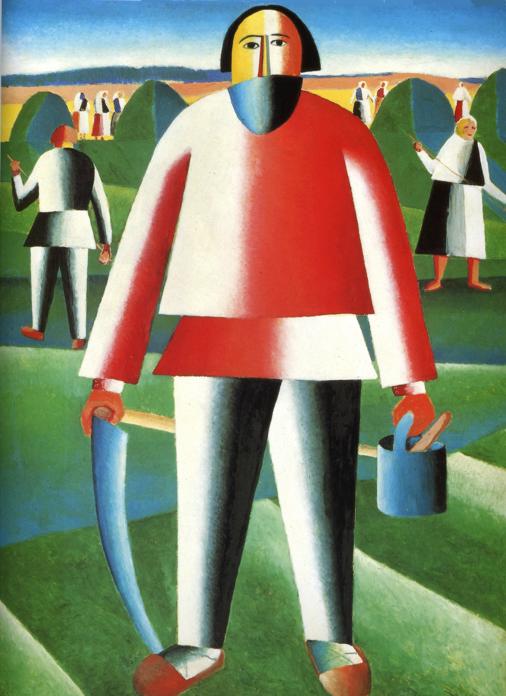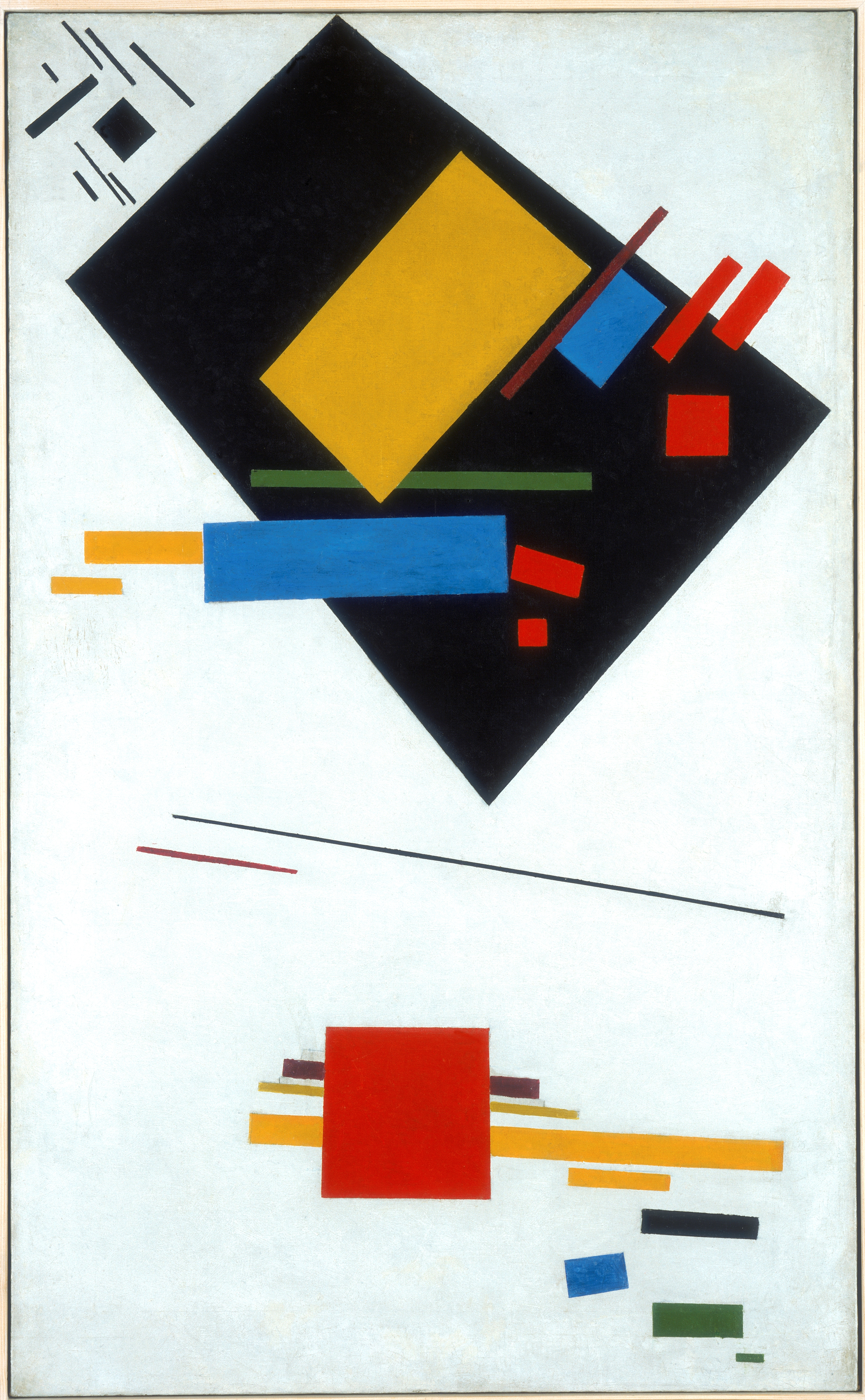
 We do run a lot of initiatives, Stay on top of things!
We do run a lot of initiatives, Stay on top of things!
This January 2013 I was working on a Malevich’s case and I went through some literature on the technical art examination related to this painter. This post wants to share some thoughts. Fortunately, even if based in Sicily, I have proactive collaborators that live close the most important libraries in the US and help me have access to technical art literature which I can so cozily read in my studio, under the mild Sicilian weather. For a brief introduction to Malevich, I suggest the essay [1] which Matthew Drutt prepared in the occasion of the exhibition catalog “ Kazimir Malevich: Suprematism. Investigating the birth of the Suprematist movement.” To have a handy collection of Malevich’s works helpful is the Kindle ebook of annotated reproductions of 170 selected drawings and paintings by Maria Tsaneva [2]. More deep reading could be the actual Malevich’s essays on his art creative method – he was a proactive writer – “From Cubism and Futurism to Suprematism” (1916) and “From Cézanne to Suprematism” (1920).
[post-content post_name=pigments-checker-in-brief]
Briefly, Kazimir Malevich was a Russian, specifically, Ukrainian, painter and an art theoretician which pioneered the geometric abstract art and developed the avant-garde, Suprematist movement. He initially combined Russian folk painting with Symbolism, Impressionism and Fauvism. Then he was introduced to Cubism, which was having great influence in Russian artists and, eventually, from about 1915 Malevich introduced a totally original kind of painting, the “Suprematism” which aimed to gain “pure experience” just through abstract geometric shapes. The largest collection of his works are at the Tretyakov Gallery in Moscow, Tate Modern in London, Stedelijk Museum in Amsterdam and the Museum Ludwig, in Cologne, Germany.
As for technical examination references, an exhibition in the United States (1990-1991) occasioned two first extensive scientific study of Malevich working method [3, 4]. These were followed in 2002 by a publication of the State Russian Museum [5]. Recently the InCoRM (The International Chamber of Russian Modernism) institute published another technical paper [6]. Andrei Nakov on the occasion of the catalogue raisonee’ wrote an extensive article in 2008 [7].
Malevich is known to have changed his working methods many times and seems not to be a linear development in his technical developments. For sure he was always concerned specifically with the textural appearance of his oeuvre. He wrote, “Color and texture in a painting are ends in themselves, the very essence of painting.” Following some observations on Malevich paintings and their features:
Painting Techniques
Federov-Davydov acknowledged in 1929 ” …even though Malevich’s art seems to us in large measure ideologically remote, his formal qualities and the strictly painterly mastery of his works are essential for the development of our artistic culture.” The professional quality of Malevich’s paintings was recognized even by his contemporary non-avant-gardist colleagues. During his life Malevich worked in many different styles. He produced impressionist paintings using a conventional Impressionist painting techniques –“alla prima” application of thick paint and building of form and volume through color. Characteristic of this period is that the thick paint is allowed to dribble and to form a peaked ridge along the edges of the brushstrokes. Malevich considerably relied on academic painting technique. Though, later paintings, 1930s, are characterized by a greater lack of inhibition, variety, and confidence in the brushstrokes. Malevich painted some of his subjects following Leonardo’s advice which stated that if a transparent color is placed over another, a new color is formed. There are many examples of Malevich covering red or violet areas with thin, transparent layers of black.
The white background is of the main importance in his Suprematist works. A restorer from the Conservation Center in Dusseldorf observed: ” the touch of the brush is brief and irregular, heavily coated and applied in a cruciform manner.”
As a note, Malevich didn’t sign Suprematism paintings in the front because that was in his view making his composition just and “illustration.”

Texture
Malevich said that “the most important elements in painterly creation are color and texture: these are the essence of painting, but this essence has always been annihilated by the subject.”
He also stated: “Cubism, besides its constructive, architectonic and philosophic content, had various forms of surface treatment” which are, indeed, visible in his cubo-futuristic paintings: surfaces are in relief, enameled, rough, lacquered, and mat.
He figured out to use pigments with different opacity to subtlety differentiate planes. So zinc white is used in the same painting together with lead white. He wanted to achieve a texture differentiation (reflectance and opacity) within the same color.
Unfortunately, the subtly Malevich’s technique was not understood by western conservators in the 50s and 60s which regarded his work under the “geometric aesthetic” and attempted interventions which “stripped” the paintings of their finishing layer and, with heavy relining, “ironed out” (flattened) their texture. It is also documented that the size of the paintings was also modified, during the relining, to achieve a “correct” rectangular proportion.
Underdrawing
He used different sketching methods. There are paintings which show a brush drawing, others detailed preparatory drawing on the priming in pencil or charcoal. Malevich often left these underdrawing partially visible on purpose. Suprematist works are mostly done with freehand pencil.
Kazimir Malevich, Peasants, 1928. The underdrawing is left partially visible. See waist of the figure on the right.
Key features: cardboard guide
In order to paint a clean edge for his geometrical shapes, Malevich used a cardboard to guide his brush. This is well visible since when the cardboard was placed on wet paint, once lift, it left a characteristic ridge.
Key features: white on white
Malevich had a very non traditional sequence method to color the geometrical figure. 1. draw with a pencil the lines of the figures on the white ground. 2. paint the ground surrounding the lines with white paint. 3. Eventually paint with the desired color the inside of the figure.

Craquelure
A number of his paintings show extensive craquelure, one for all, the famous Black Square (1915). This is due to his practice of painting over the surface of works before they had completely dried.

Canvases
Malevich used machine primed canvases and hand-primed jute and flax canvases. Most of the paintings before 1915 are painted on coarse granular jute canvases prepared by the artists, sized with starch and primed with a grey-tone coating (chalk, kaolin, zinc white, lead white). Later on he used flax canvases with still a grey priming containing zinc white. Later works are characterized by a very thin layer of priming, a detailed preparatory drawing (pencil or in charcoal) and thin paint.

Painter’s retouches
Malevich retouched and sometimes radically repainted many of his oeuvre. It is not rare to notice even by naked-eye the shapes of covered up figures in his paintings or seeing their colors through the craquelure.


Dating Malevich’s paintings
Dating is an extremely complex task for Malevich’s oeuvre. Indeed, it is known that he intentionally misdated his pieces.
Pigments
The pigments documented in Malevich works are: zinc white, vermilion, chrome green, cobalt blue, lamp black, Prussian blue, cadmium yellow, chrome yellow, ultramarine, organic yellow pigment, red lake, emerald green. In preparation of the western Europe exhibitions that he held in the late 1920s he retouched his paintings, often, adding a white glaze, mostly titanium white, visible in naked eye.
References
[1] Matthew Drutt “Kazimir Malevich: Suprematism” The Solomon R. Guggenheim Foundation, New York. Guggenheim Museum Publications, 2003.
[2] Maria Tsaneva “Kazimir Malevich: 170 Masterpieces” Amazon Kindle Edition, 2013
[3] M. Vikturina; A. Lukanova “A study of technique. Ten paintings by Malevich in the Tretiakov Gallery” In: Kazimir Malevich, Armand Hammer Museum/Washington Press: Los Angeles,1990.
[4] A. Hoenigswald “Kazimir Malevich’s Paintings: Surface and Intended Appearance” Conservation Research 1996/1997. Studies in the History of Art 57. Monograph Series II. National Gallery of Art: Washington DC (1997) pp. 109-25.
[5] S. Rimskaya-Korsakova “Concerning the technological research of Malevich’s paintings” In: Petrova, Y. (ed.) Kazimir Malevich in the State Russian Museum, Palace Editions: St. Petersburg, 2002.
[6] Petra Mandt “The Paintings of Kazimir Malevich in the Ludwig Collection from the Art-Technological Point of View” InCoRM Journal V3 2012
[7] Andrei Nakov, Maev de la Guardia and Tomás de la Guardia “Devices, Style and Realisation: Professionalism in Malewicz’s Painting Technique” Artibus et Historiae, Vol. 29, No. 57, pp. 183-239, 2008.





Very interesting and helpfull for my lessons!
you are welcome!
Nice overview. Am presently studying a Malevich so your short essay saved me time and provieded some ref that I can follow up. Thanks. We should share some thoughts. JB
Hi Jaap, thanks so much for the appreciation of the post on Malevich. It is always nice to receive a spontaneous positive feedback, especially from a colleague with such an outstanding and long experience. Would be a pleasure have a talk with you!
Hi great posts here and wonderful art. I just purchased a fine ink “intaglio” and I can’t id the artist signature, anyway if anyone has a chance here is my photostream to view the pictures.. Thanks ahead of time.
https://www.flickr.com/photos/128271177@N03/
Hi thanks for the interest on this blog. Uhm, unfortunately I can’t help you. Hope somebody else following this blog can.
this is wonderful. Is there any more material to share?
For the best I know, the suggested literature on this post is all that has been published about Malevich technical studies so far.
Wonderful lesson. Who would I contact on going down the road to authenticating one of his paintings!
Hi Jerry,
thanks a lot for your appreciation on this post on Malevich. Authentication is long way process which involves a number of professionals, scientists, such as me, as well as conservators and art historians who are considered references for each specific painter. I just do the technical examination part but I could give you some advises.
This is a great find especially as I am about to embark on some Malevich paintings for a film. Thanks!
good luck with your study )))
Just discovered your wonderful essay on Malevich. He is one of my favorite painters. Thank you so much for explaining his technique. I wish you would do this with Paul Klee as well.
thanks! no plans for Klee, sorry 🙁
You mention that Malevich never signed his suprematist paintings on front however many of his suprematist studies on paper .Most of his paintings are signed or unsigned . Did Malevich himself make this statement or is it only somebodies opinion?
Hi Romeo,
nice to hear from you. This info, as the others in the posts about Painters are based on published resources that I reviewed. As for this specific question, I think this is somebody’s opinion, not a statement from Malevich himself